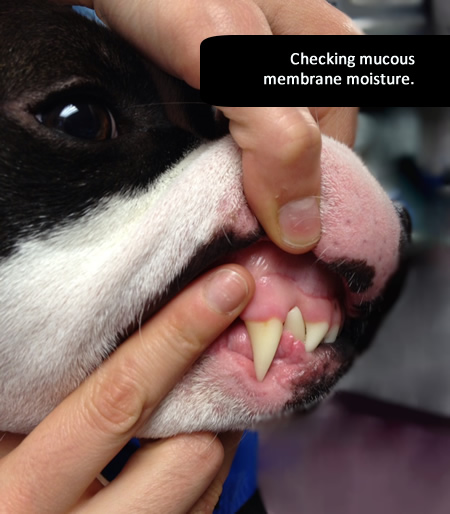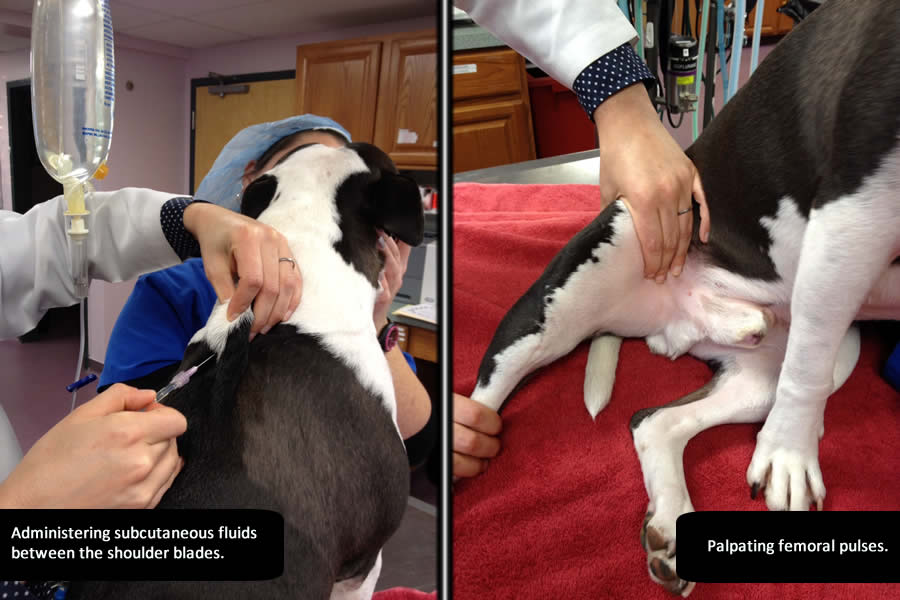Water is vital to life. In my practice I've seen emaciated dogs, where food was withheld for weeks, trot right into the practice and recover easily once food was reintroduced. Prevent access to water for even a few hours in the wrong conditions and you are presented with a collapsed dog with complications that mount quickly. Death can occur not only from severe dehydration, but also from inappropriate rehydration. Quick and accurate assessment of the dehydrated animal is essential for the best possible outcome.
In the animal's body, water is a solvent, a chemical reactant, a lubricant, provides shape and resilience to organs, and assists in regulation of body temperature. Water has a high specific heat (specific heat is amount of heat needed to raise one gram of water one degree Celsius). A well-hydrated animal is, therefore, less sensitive to extremes in environmental temperature than a dehydrated one. This is especially important in cold weather outdoor activity when animals are less likely to drink but need good hydration to keep warm.
On a side note: many people ask me about allowing dogs to drink unfiltered water on the trail. Dogs are susceptible to many of the same viruses, parasites, and bacteria that humans are when drinking unfiltered water, so it's probably safest to share your clean water with them. If you do let your dog drink from unfiltered water sources, use common sense. Make sure the water is moving and clean looking. Make sure your dog is on a monthly oral dewormer prescribed from your veterinarian and have a fecal sample checked at least yearly. I regularly find the parasite Giardia in the stool of my patients and many are without symptoms.
Hydration
Good hydration is all about water balance. In the hospital we tract "In vs. Out" - water in via food and drink; water out via urination, defecation, evaporation and perspiration. Dogs do not have significant losses to perspiration because they only sweat from their paw pads. However, they do have significant losses from evaporation through panting. (This is species specific. Horses sweat from their skin like humans, but no do not pant.)
Resting dogs require approximately 40-60 ml/kg/day of water. This tends to be overestimated for giant dogs and underestimated for toy dogs. For the average 50 lb. dog this calculates to about one liter per day at rest. Water is also taken in with diet. Animals consuming mostly wet diets will drink less than those eating commercial kibble or dehydrated foods.
Water requirements can increase three-to-four times with activity and temperature extremes. Studies of hunting dogs in Norway in winter conditions have shown that cold weather activity water requirements are similar to those in hot weather - approximately 3.5 liters per day in this study. When hiking with my Labrador sized dogs (50-75 lbs.) I plan for at least two one-liter Nalgene bottles per dog per day divided among many stops throughout the day.
Assessing Dehydration
Water balance in the body is delicate. Dehydration is a fluid deficit in the interstitial or intracellular space. Severe dehydration will lead to perfusion problems caused by fluid loss in the intravascular space. Dehydration of more than a few percent will cause illness and dehydration of more than 15 percent can cause death.

Accessing hydration status can be difficult since less than three percent dehydration is not clinically noticeable and only a few outward parameters may be altered by more severe water loss (see chart). Darkening of urine color, increased urine odor, and decreased output of urine maybe noted with moderate dehydration, but is also affected by many other factors. Therefore, these are not reliable hydration status parameters. Deceased mucous membrane moisture, evident as sticky mucous membranes, is one of the first noticeable signs of dehydration. Lift the lip of the dog and touch the gums above the large canine tooth. It should by moist and slippery. Do not bother touching the nose. A dry dog nose is NOT a sign of disease or hydration status, despite popular belief.

Skin moisture is accessed by the elasticity of the skin. Tent the skin on the dogs back between the shoulder blades (see video below/ image). It should quickly, with in one-two seconds, bounce back into the original position. Skin that remains tented or is slow to recover to its initial position is associated with moderate dehydration. Sunken eyes and dull corneas are associated with severe dehydration. At this stage you may also see slowed response times, ataxia (off balance), and dull mentation. Severely dehydrated animals can be hypovolemic resulting in poor perfusion. These animals are in shock, although may be compensatory. They are slow, weak, tachycardic (heart rate above 140), and have poor pulses.
To evaluate pulse quality in the dog, the femoral artery on the medial aspect of the proximal thigh is the most easily palpated. Animals with poor perfusion need immediate veterinary emergency care. Initial field treatments described below can be initiated, but these animals need to be transported out of the field for careful IV rehydration with crystalloid and colloid fluids.

Rehydration
The first step in a rehydration plan is to calculate the patient's fluid deficit. The fluid deficit in liters is the percent dehydration x weight in kilograms.
% dehydration x body weight in kg = fluid loss in liters.
Example: A 50 lb. (22kg) dog estimated to be 7% dehydrated
.07 x 22 kg = 1.5 liters
So this patient needs an additional 1.5 liters of water to correct for dehydration.
Mild acute dehydration (less than five percent and no longer than a day's duration) is easily remedied with access to clean water. Most animals will drink to replace these losses on their own without having to closely monitor water intake. Warm water added to high energy dry kibble could be used at mealtime to make up for the days water losses.
Acute moderate to severe dehydration may result in debilitated animals that will not readily drink on their own. These dogs can be tempted to drink by adding a tasty flavoring to the water. Bouillon cubes and meat flavorings can be used. I have found that the canine probiotic supplement, Fortiflora, added to water attracts many dogs to drink. This powdered supplement comes in individual pouches making it packable and light. Electrolyte supplements designed for humans have been recommended to alternate with water for rehydration in dogs; however, most dogs do not find them palatable.
Acute dehydration losses should be corrected over one-to-four hours and the animal should be monitored closely. If hydration status appears normal by the next day activity can resume, but future water intake should be monitored. While rarely seen, water intoxication via overconsumption is possible in severely dehydrated animals of a long duration offered free access to water. If unsure about the duration of dehydration it is best to rehydrate slowly over 24 hours. Cerebral edema can occur with overzealous rehydration in animals with hyperosmolarity from prolonged dehydration. Watch for neurological signs, including dull mentation, ataxia, anisocoria (uneven pupil size), and head pressing while rehydrating these animals.
For animals with moderate to severe dehydration who will not drink enough on their own, or for animals with perfusion problems, parental fluid administration will be needed. Since IV catheter placement in the dog can be difficult for non-veterinary trained personnel, IV fluid resuscitation is best left to the hospital setting. However, for practitioners with experience and supplies, subcutaneous fluid administration in the dog is relatively easy to administer if balanced isotonic fluids, a fluid line, and a 22-18g needle is available (see video).
Balanced electrolyte solutions, such as Lactated Ringers Solution, Normosol R, Plasmalyte A or even 0.9% saline (saline will sting a bit), can be used. The fluid bag is connected to a fluid line and an 18-gauge needle, and then both are primed. The skin between the shoulder blades should be tented and the needle, connected to the line and bag, is inserted under the skin. The fluid bag is held above the body for gravity flow of fluid into the subcutaneous tissue. Once the fluid starts to flow the animal may react, especially if the fluids are cold, but usually the animal can be held and kept calm. This is not painful. Some references recommend no more than 200 ml of fluids per site, but I have regularly given 500 ml of fluids under the skin without complications. You will not be able to correct all fluid losses via subcutaneous administration, but it can be a compliment to oral rehydration, or the initial treatment prior to evacuation and veterinary emergency care.
Prevention is the key to early success, so calculate your animal's fluid needs and encourage them to hydrate just like the rest of the team.